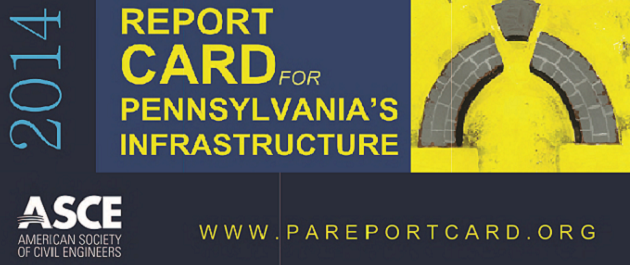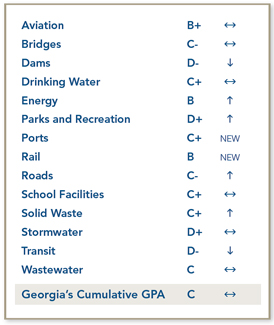Pennsylvania Earns 7 Poor D Grades in New Report Card
June 25th, 2014 | By: Infrastructure Report Card
Today, civil engineers from across Pennsylvania released a new Report Card for Pennsylvania’s Infrastructure giving 16 grades for the state’s infrastructure. Here’s how Pennsylvania’s infrastructure ranks from worst grades to best: Roads D- Wastewater D- Drinking Water D Transit D Bridges D+ Inland Waterways D+ Stormwater D+ Dams C- Levees C- Schools C- Energy C Solid Waste C+ Ports C+ Hazardous Waste B- Parks and Rec B- Freight Rail B The Report Card found that Pennsylvania faces immense challenges to maintaining and modernizing infrastructure throughout the state:- Pennsylvania has the highest percentage of structurally deficient bridges in the country. Of the Commonwealth’s more than 22,000 bridges, nearly one in four are considered structurally deficient.
- Pennsylvania has the most combined sewer overflows (CSOs) of any state.
- The Commonwealth must invest $28 billion over the next 20 years to repair existing wastewater systems, meet clean water standards and build or expand existing systems to meet increasing demands
- Pennsylvania’s 1.3 traffic fatalities per 100 million miles of travel is significantly higher than the national average (1.1).
- KEEP UP THE MOMENTUM FOR BETTER INFRASTRUCTURE: In 2013, Pennsylvania’s officials showed leadership by passing a transportation package that will start putting the roads, bridges, and transit systems back into working order.
- AFFIRM PUBLIC SAFETY AS GOVERNMENT’S #1 JOB:Whether it’s repairs to bridges, ensuring safe drinking water, or keeping up on dam safety inspections, public safety must always be the first priority as leaders budget and plan for the future. Ensuring infrastructure is resilient and online 99.9% of the time will keep communities safe and the economy thriving.
- STOP WASTING MONEY BY WAITING: Of the 7 infrastructure categories with D grades, all of these deal with transportation and water systems, and much of the repairs and long-term funding are being short-changed. Waiting will only lead to larger issues that will disrupt lives and cost even more when the bill comes due. Pennsylvania must look at the full cost of decisions and then put savings to use.
Tags: Act-89, grades, momentum, Pennsylvania, report card, states, transportation, water
No Comments »
Everything You Need to Know About the 2014 Water Resources Reform Development Act
June 17th, 2014 | By: Whitford Remer
President Obama last week signed a $12.3 billion water resources bill that will modernize critical water infrastructure while also promoting economic growth and job creation. The Water Resources Reform and Development Act of 2014 (WRRDA) authorizes 34 new Army Corps projects, establishes a new loan financing program, strengthens levee and dam safety programs and codifies new reforms to the project review process. There are a number of significant victories for ASCE and the nation’s infrastructure. The legislation is the first major water resources bill in seven years and is being applauded by organizations across the spectrum. ASCE’s 2013 Report Card for America’s Infrastructure graded the nation’s ports a C, inland waterways a D-, dams a D, and levees a D-. ASCE lobbied Congress to pass the bill and is particularly supportive of the Levee Safety Initiative and The National Dam Safety Program. The national Levee Safety Initiative will promote consistent safety standards, create levee safety guidelines and provide funding assistance to states for establishing participating levee safety programs. WRRDA authorizes $395 million to support levee safety initiatives and $70 million over five years for dam safety. Once funded, these programs will provide critical resources necessary to improve the safety of the nation’s dams and levees. The bill also solves long standing expenditure issues in the Harbor Maintenance Trust Fund (HMTF). WRRDA authorizes that 100% of funds collected by the HMTF to be allocated to the intended purpose (dredging the nation’s ports and harbors) by 2025. Previously only a fraction of funds collected by the fund were used to support port and harbor programs. The bill also allocates 10% of HMTF expenditure for emerging harbors. WRRDA makes a number of changes to the popular Clean Water State Revolving Fund (CWSRF) and creates a new water financing pilot program similar to TIFIA for surface transportation projects. The new SRF provisions provide loan flexibility, lower interest rates and extended repayment periods of 30 years. SRF funds may also now be used to implement watershed plans, water conservation, stormwater recapture, and for technical assistance to small and medium treatment works. A significant win for the engineering community is the requirement for the use of the Brooks Act qualifications based selection for A/E services or an equivalent State qualifications-based requirement (as determined by the Governor of the State when using SRF fund). ASCE has worked to include this provision for over 10 years. The Water Infrastructure Finance and Innovation Act (WIFIA) is intended to increase flexibility for non-federal interests and leverages private sector investments to increase the effect of federal funding. The new WIFIA program can be used for traditional clean water and drinking water project, and also will provide assistance to projects with the goal of reducing flood damage; restoring aquatic ecosystems; improving inland and intracoastal waterway navigation systems. Finally, the bill includes new reforms at the U.S. Army Corps of Engineers that codifies a new internal expedited project delivery process that limits feasibility studies to 3 years at a cost of no more than $3 million in federal funding. ASCE applauds Congress for their bipartisan work passing WRRDA. We look forward to working with appropriators to ensure these programs and projects are properly funded.Tags: clean water, dams, economy, levees, sustainability, water, waterways, wrrda
2 Comments »
ASCE commends passage of Water Resources Reform and Development Act
May 22nd, 2014 | By: Becky Moylan
Washington, D.C. — The following is a statement from Randall (Randy) S. Over, P.E., F.ASCE, president of the American Society of Civil Engineers (ASCE), regarding the final passage today of the Water Resources Reform and Development Act by the U.S. Senate and House of Representatives: “Today’s congressional passage of the Water Resources Reform and Development Act (WRRDA) is a defining moment for the nation’s ports, inland waterways, dams, levees and clean water infrastructure. The bill will provide significant funding — $12.3 billion over ten years — to modernize critical infrastructure while also promoting economic growth and job creation. “ASCE’s 2013 Report Card for America’s Infrastructure graded the nation’s ports a C, inland waterways a D-, dams a D, and levees a D-. Since the release of our 2013 Report Card, we’ve urged Congress to pass water resources legislation that would revitalize these languishing sectors. After seven years with no legislative action to modernize the nation’s water resources, this bill will definitively move the ball forward to help raise the grades on America’s infrastructure.“ASCE applauds Congress for its decisive and bipartisan action in getting WRRDA over the finish line. This bill will ensure that our nation’s ports, waterways, dams and levees receive the funding they require so that the United States remains competitive in the 21st century. We look forward to the legislation being signed into law by the president in the coming days.”
Founded in 1852, the American Society of Civil Engineers represents more than 145,000 civil engineers worldwide and is America’s oldest national engineering society. ASCE’s 2013 Report Card for America’s Infrastructure, graded America’s cumulative GPA for infrastructure at a D+. The Report Card app for Apple and Android devices includes videos, interactive maps and info-graphics that tell the story behind the grades, as well as key facts for all 50 states. For more information, visit www.asce.org and follow us on Twitter, @ASCETweets and @ASCEGovRel.###
Tags: congress, dams, infrastructure, levees, ports, water, water infrastructure, wrrda
No Comments »
ASCE Applauds U.S. Senate Conference Report on Water Resources Reform and Development Act
May 15th, 2014 | By: America's Infrastructure Report Card
Washington, D.C. — The following is a statement from Randall (Randy) S. Over, P.E., F.ASCE, president of the American Society of Civil Engineers (ASCE) regarding the conference report on the Water Resources Reform and Development Act by the U.S. Senate: “Today’s release of the conference report on the Water Resources Reform and Development Act (WRRDA) represents a major victory in providing the necessary funding to modernize the nation’s ports, inland waterways, dams and levees. The bill promotes economic growth and job creation through policies that strengthen U.S. infrastructure, allowing the United States to remain competitive in the 21st century. “ASCE’s 2013 Report Card for America’s Infrastructure graded the nation’s ports a C, inland waterways a D-, dams a D, and levees a D-. Our nation’s water resources are critical to our economy, our infrastructure, public safety, and the preservation and enhancement of our environmental resources. In fact, ASCE’s Failure to Act economic study on the nation’s marine ports and inland waterways shows that underinvesting in just these two sectors threatens more than one million U.S. jobs and $270 billion in U.S. exports by 2020. “WRRDA will drastically reduce the time it takes for project approvals by consolidating or eliminating duplicative studies, allowing concurrent reviews, and streamlining environmental reviews. The significant reforms in the law are not at the expense of environmental quality and will allow for a stronger, safer national water resources infrastructure. In addition, ASCE applauds the reauthorization of the National Dam Safety Program, the strengthening of the Levee Safety Initiative, and the efforts to put the trust back into the Harbor Maintenance Trust Fund so that our nation’s ports can remain competitive on a global level. “ASCE is pleased that Congress has collaborated on a final conference report on WRRDA to invest in America’s future. This decisive action will ensure that our nation’s ports, waterways, dams and levees receive much-needed funding. We look forward to the final vote next week and the legislation being signed into law by the president.” Founded in 1852, the American Society of Civil Engineers represents more than 145,000 civil engineers worldwide and is America’s oldest national engineering society.###
Tags: congress, dams, infrastructure, levees, ports, water, wrrda
No Comments »
How Much Would You Owe If Everyone's Infrastructure Bill Came Due?
April 29th, 2014 | By: Infrastructure Report Card
Bloomberg took the opportunity to calculate your infrastructure bill for you based on where you live. See what you would owe for roads, safe drinking water, and airport infrastructure if every one in every state had to pay their bill today.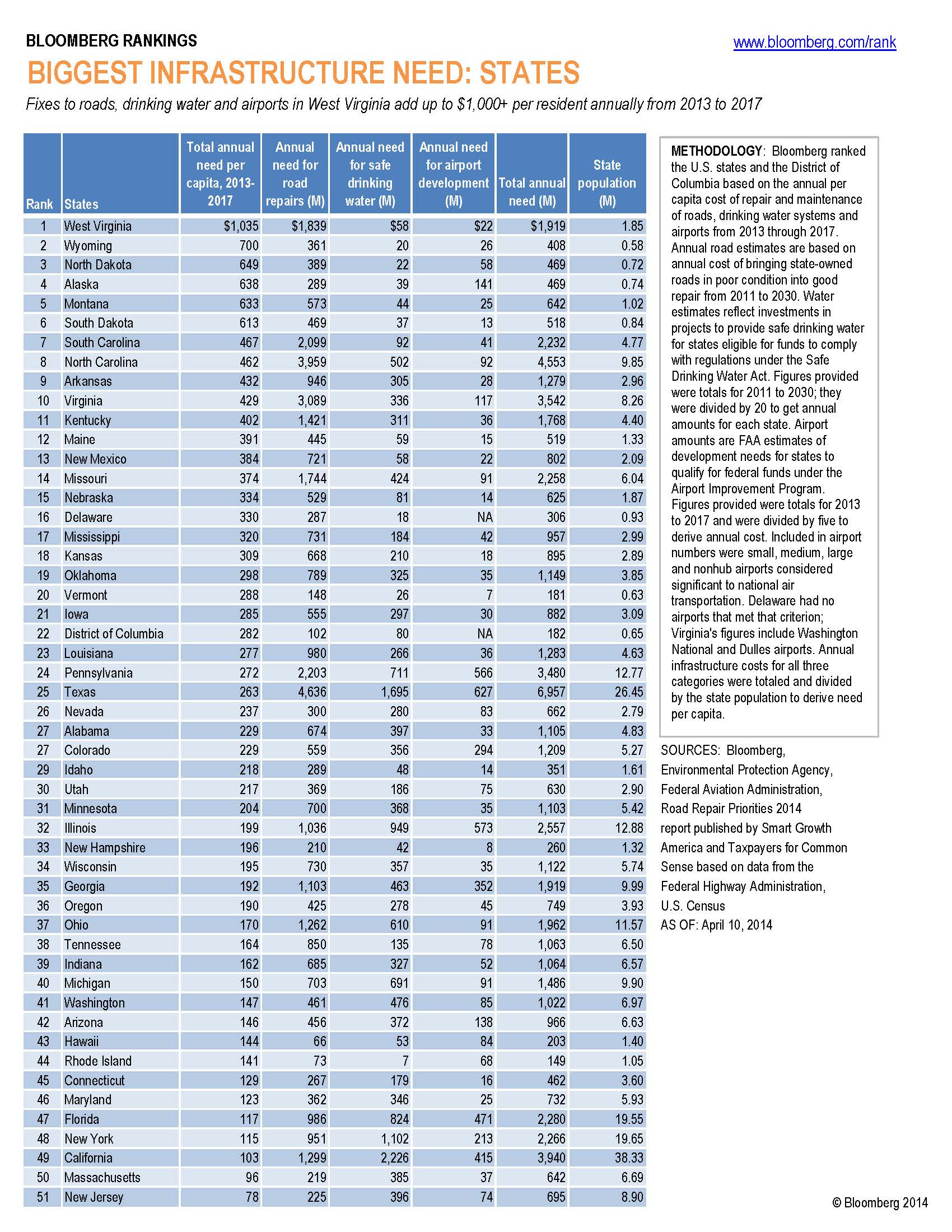
Tags: aviation, bill, infrastructure, rank, roads, water
1 Comment »
New Report Card for Illinois' Infrastructure Shows Progress
April 2nd, 2014 | By: Infrastructure Report Card
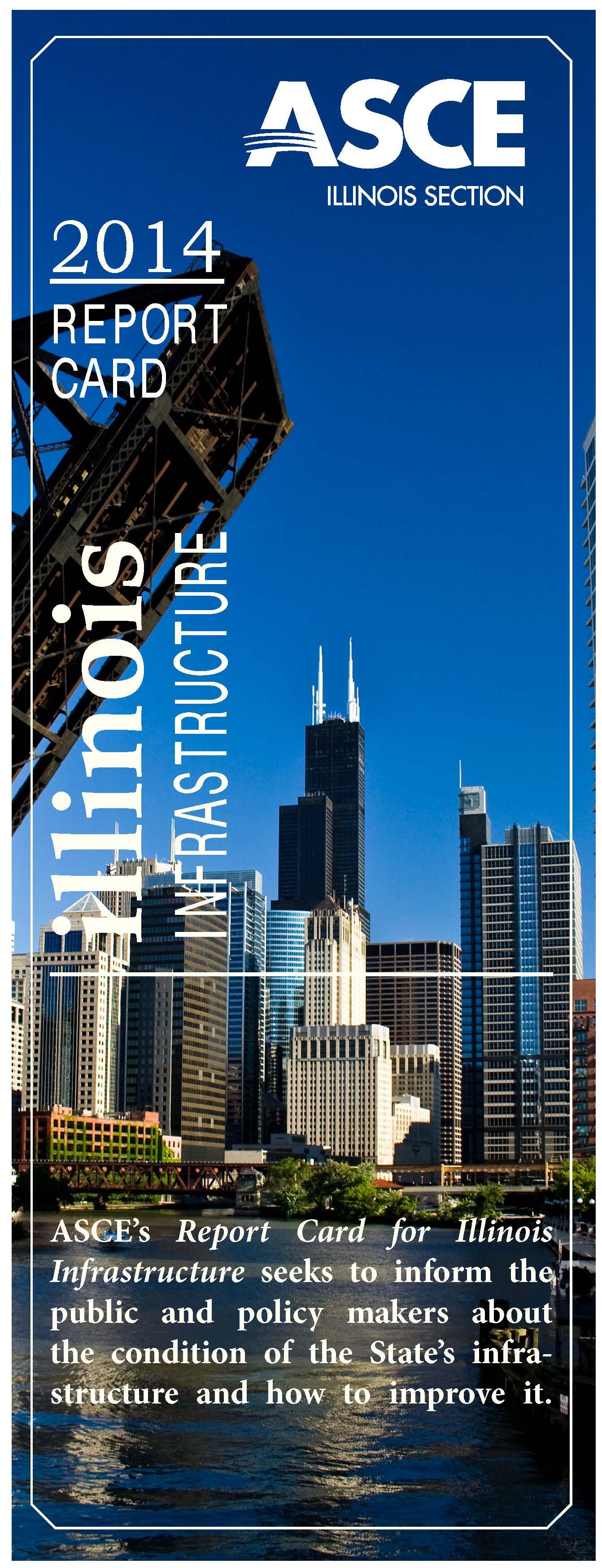 The 2014 Report Card for Illinois’ Infrastructure was released today by the Illinois Sections of the American Society of Civil Engineers (ASCE) at the Illinois Statehouse.
A panel of professional civil engineers throughout the state graded each infrastructure category according to the following eight criteria: capacity, condition, funding, future need, operation and maintenance, public safety, resilience, and innovation. In 2010, the infrastructure grade for Illinois was a D+, reflecting delayed maintenance and underinvestment across most categories. In the 2014 Report Card for Illinois’ Infrastructure, the state’s infrastructure G.P.A. jumped to a C- showing the progress made with leadership and solid infrastructure programs.
Over the past four years since the 2010 Report Card for Illinois’ Infrastructure, leaders at the state level and in Illinois’ cities—large and small—have started to make some steps to rebuild their aging infrastructure. Programs such as CREATE have started unclogging rail and traffic bottlenecks and the Illinois Jobs Now! effort by the state provided $31B to start fixing Illinois’ biggest infrastructure problems. These efforts have paid off and both the Rail and Drinking Water grades have gone up since the last Report Card. Plans like Chicago’s commitment to replace and repair aging water pipes shows how “thinking big” can create even bigger results.
But while some of the grades have gone up, Illinois’ infrastructure isn’t a B student yet. Aging infrastructure and delayed maintenance have taken their toll. Illinois’s average bridge is 40 years old which is close to retirement age for a bridge, Chicago has been replacing water pipes put in when Ulysses Grant was President, and more and more people and goods spend time stuck in traffic on Illinois’ roads and rails.
Let’s Raise the Grades
Illinois’s infrastructure touches almost every aspect of citizens’ daily life—from your neighborhood roads, to your phone, to the community school, to the new south suburban airport. In 2014, we need to be visionary but realistic about our infrastructure. We need to continue replace our oldest infrastructure but also begin to think of our infrastructure as an entire system in need of sustainable funding. We have to make collaborative and smart decisions, while assuring that safety remains our top priority.
We can continue to tackle Illinois’ infrastructure needs by asking our leaders to take on these 3 Key Solutions that would help and raise Illinois’s grades:
1. State and local governments should work together to create smart, efficient transportation systems that meet the changing needs of Illinois’s communities. We cannot just repair the investments of the past, but we need to build systems for a 21st century Illinois.
2. Create sustainable funding to maintain all new and planned investments in Illinois’s water systems. Simply replacing old pipes with limited or no plans for operation and maintenance will only lead to similar problems for future generations.
3. Invest in networks that will lessen the costs of doing business in Illinois, including inland waterways, rail, and airports. As the economy continues to expand, Illinois needs world-class infrastructure to compete with other states for new businesses and manufacturing.
Read the full 2014 Report Card for Illinois’ Infrastructure here.
The 2014 Report Card for Illinois’ Infrastructure was released today by the Illinois Sections of the American Society of Civil Engineers (ASCE) at the Illinois Statehouse.
A panel of professional civil engineers throughout the state graded each infrastructure category according to the following eight criteria: capacity, condition, funding, future need, operation and maintenance, public safety, resilience, and innovation. In 2010, the infrastructure grade for Illinois was a D+, reflecting delayed maintenance and underinvestment across most categories. In the 2014 Report Card for Illinois’ Infrastructure, the state’s infrastructure G.P.A. jumped to a C- showing the progress made with leadership and solid infrastructure programs.
Over the past four years since the 2010 Report Card for Illinois’ Infrastructure, leaders at the state level and in Illinois’ cities—large and small—have started to make some steps to rebuild their aging infrastructure. Programs such as CREATE have started unclogging rail and traffic bottlenecks and the Illinois Jobs Now! effort by the state provided $31B to start fixing Illinois’ biggest infrastructure problems. These efforts have paid off and both the Rail and Drinking Water grades have gone up since the last Report Card. Plans like Chicago’s commitment to replace and repair aging water pipes shows how “thinking big” can create even bigger results.
But while some of the grades have gone up, Illinois’ infrastructure isn’t a B student yet. Aging infrastructure and delayed maintenance have taken their toll. Illinois’s average bridge is 40 years old which is close to retirement age for a bridge, Chicago has been replacing water pipes put in when Ulysses Grant was President, and more and more people and goods spend time stuck in traffic on Illinois’ roads and rails.
Let’s Raise the Grades
Illinois’s infrastructure touches almost every aspect of citizens’ daily life—from your neighborhood roads, to your phone, to the community school, to the new south suburban airport. In 2014, we need to be visionary but realistic about our infrastructure. We need to continue replace our oldest infrastructure but also begin to think of our infrastructure as an entire system in need of sustainable funding. We have to make collaborative and smart decisions, while assuring that safety remains our top priority.
We can continue to tackle Illinois’ infrastructure needs by asking our leaders to take on these 3 Key Solutions that would help and raise Illinois’s grades:
1. State and local governments should work together to create smart, efficient transportation systems that meet the changing needs of Illinois’s communities. We cannot just repair the investments of the past, but we need to build systems for a 21st century Illinois.
2. Create sustainable funding to maintain all new and planned investments in Illinois’s water systems. Simply replacing old pipes with limited or no plans for operation and maintenance will only lead to similar problems for future generations.
3. Invest in networks that will lessen the costs of doing business in Illinois, including inland waterways, rail, and airports. As the economy continues to expand, Illinois needs world-class infrastructure to compete with other states for new businesses and manufacturing.
Read the full 2014 Report Card for Illinois’ Infrastructure here.
Tags: Illinois, infrastructure, report card, solutions, transit, transportation, vision, water
No Comments »
Success Story: Louisville’s Riverbank Filtration Projects are Innovating with Nature
February 12th, 2014 | By: Infrastructure Report Card
When change is needed, water utilities like the Louisville Water Company also look to see what else can be improved in the process. The Riverbank Filtration Tunnel and Pump Station project at the B.E. Payne Treatment Plant was developed in Louisville to exceed new regulations that took effect in 2012 by the Safe Drinking Water Act. This new video explains how this innovative project works to harness nature to better serve their community. The project includes combining a gravity tunnel with wells as a source for drinking water, making the Louisville Water Company the first water utility in the world to do so. The project uses the Riverbank Filtration process—a “green supply” purification method using natural filtering of a riverbank to remove contaminants. By using a natural filtration process, the project saves the state money and will result in fewer water main issues. To learn more about the project, visit the project profile or this article. If you’d like to know more about Kentucky’s infrastructure, get a great summary of the issues here in their Infrastructure Report Card.Tags: Kentucky, report card, success, sustainability, water
No Comments »
Georgia's C Infrastructure
January 13th, 2014 | By: Infrastructure Report Card
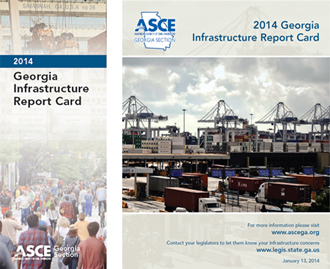 Georgia’s infrastructure has failed to improve over the last five years. In a new report, titled the 2014 Report Card for Georgia’s Infrastructure, the Georgia Section of the American Society of Civil Engineers (ASCE) awarded the state’s infrastructure a “C,” a grade unchanged from their 2009 Report Card. The lowest grade awarded was a “D-”, which went to the state’s dams and transit systems. The Report Card’s highest grade, a “B,” was given to Georgia’s energy and rail systems. Georgia’s growing population combined with cutbacks in infrastructure funding resulted in many of the low grades.
Specifically, the Report Card finds that Georgia is lagging in sustainable investment, including:
Georgia’s infrastructure has failed to improve over the last five years. In a new report, titled the 2014 Report Card for Georgia’s Infrastructure, the Georgia Section of the American Society of Civil Engineers (ASCE) awarded the state’s infrastructure a “C,” a grade unchanged from their 2009 Report Card. The lowest grade awarded was a “D-”, which went to the state’s dams and transit systems. The Report Card’s highest grade, a “B,” was given to Georgia’s energy and rail systems. Georgia’s growing population combined with cutbacks in infrastructure funding resulted in many of the low grades.
Specifically, the Report Card finds that Georgia is lagging in sustainable investment, including:
- Georgia ranks 49th in the nation in per capita transportation funding.
- Georgia is among the lowest in the country in transit spending per resident. According to the American Public Transportation Association’s 2010 Survey of State Funding for Public Transportation, Georgia spent just $0.63 per person in 2008. In comparison, New Jersey spent $119.52, Illinois spent $40.43, and North Carolina spent $7.94 per person in the same year.
- Georgia’s Safe Dams Program has faced over a 50% cut in staff since 2003, with each safety official now expected to oversee over 1,000 dams, or five times the national average.
- MARTA is the largest transit agency in the country to not receive state funding support for operations
- Georgia’s state motor fuel excise tax—which funds surface transportation projects—is one of the lowest in the United States
Tags: dams, grades, infrastructure, report card, state, transit, transportation, water
1 Comment »
Georgia's Infrastructure Is On Our Mind
January 8th, 2014 | By: Infrastructure Report Card
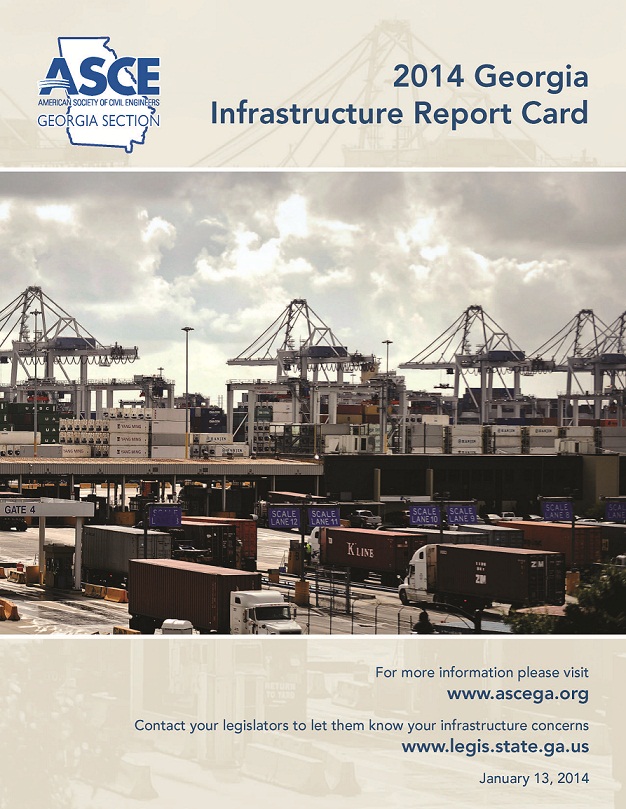 The 2014 Report Card for Georgia’s Infrastructure will be released next Monday, January 13th, in the South Wing of the State Capitol on the very first day day of Georgia’s legislative session. Highlighting the infrastructure needs across the state, the Report Card will provide a new GPA for Georgia’s infrastructure as well as new grades for specific areas — Aviation, Bridges, Dams, Drinking Water, Energy, Parks and Recreation, Ports (new), Rail (new), Roads, School Facilities, Solid Waste, Stormwater, Transit, and Wastewater.
Check back here on the 13th to find out what grades Georgia earned in the 2014 Report Card for Georgia’s Infrastructure! If you’re a supporter of Georgia’s infrastructure and in the Atlanta area, we invite you to join us for the Report Card release event:
WHAT: News conference for the release of the 2014 Report Card for Georgia’s Infrastructure
WHO: American Society of Civil Engineers, Georgia Section
Speakers: Georgia State Representative Ed Setzler
Kat Gurd, President of the Georgia Section of ASCE
Daniel Agramonte, Co-Chair of Report Card Committee
WHEN: Monday, January 13, 2014, 11:30 AM
WHERE: State Capitol South Wing
Georgia State Capitol Building
206 Washington St SW
Atlanta, Georgia 30334
WHY: Infrastructure has a direct impact on our lives every day—from the water we drink, to the schools our children attend and to the roads and rails we travel. Infrastructure is vital to our economy, security, recreation and safety. Will Georgia’s infrastructure systems make the grade?
The 2014 Report Card for Georgia’s Infrastructure will be released next Monday, January 13th, in the South Wing of the State Capitol on the very first day day of Georgia’s legislative session. Highlighting the infrastructure needs across the state, the Report Card will provide a new GPA for Georgia’s infrastructure as well as new grades for specific areas — Aviation, Bridges, Dams, Drinking Water, Energy, Parks and Recreation, Ports (new), Rail (new), Roads, School Facilities, Solid Waste, Stormwater, Transit, and Wastewater.
Check back here on the 13th to find out what grades Georgia earned in the 2014 Report Card for Georgia’s Infrastructure! If you’re a supporter of Georgia’s infrastructure and in the Atlanta area, we invite you to join us for the Report Card release event:
WHAT: News conference for the release of the 2014 Report Card for Georgia’s Infrastructure
WHO: American Society of Civil Engineers, Georgia Section
Speakers: Georgia State Representative Ed Setzler
Kat Gurd, President of the Georgia Section of ASCE
Daniel Agramonte, Co-Chair of Report Card Committee
WHEN: Monday, January 13, 2014, 11:30 AM
WHERE: State Capitol South Wing
Georgia State Capitol Building
206 Washington St SW
Atlanta, Georgia 30334
WHY: Infrastructure has a direct impact on our lives every day—from the water we drink, to the schools our children attend and to the roads and rails we travel. Infrastructure is vital to our economy, security, recreation and safety. Will Georgia’s infrastructure systems make the grade?
Tags: aviation, dams, Georgia, infrastructure, ports, roads, state, state report card, transit, water
No Comments »
Celebrating Infrastructure Successes in 2013
December 27th, 2013 | By: Infrastructure Report Card
Looking back over 2013, we have many successes in making infrastructure a priority to celebrate. Here are a few that really made our year: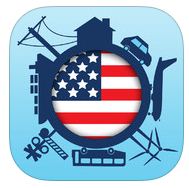 1. The 2013 Report Card for America’s Infrastructure was launched in March as a tablet and smartphone app gaining more traction with the media and decision makers than ever before and was even mentioned by President Obama during a “Rebuilding America” event at the Port of Miami.
2. Stephen Colbert showcased the uptick in America’s Report Card grades as a “Tiny Triumph” on the Colbert Report in April taking the infrastructure message to a whole new audience.
3. The Water Resources Development Act which will greatly help our ports and inland waterways deal with their pressing needs is currently in the hands of a House and Senate conference committee, and we hope to see it enacted early in 2014 (stay tuned!). It’s not too late to tell your member of Congress that this should be on Congress’ 2014 to-do list. Email them right here with a few clicks.
4. Major infrastructure funding legislative initiatives took off in several states including Maryland, Massachusetts, Pennsylvania, Virginia, Vermont, Wyoming, Texas, and Maine.
5. Several new bills were introduced that would start improving the nation’s infrastructure: The Partnership to Build America Act (H.R. 2084), which could re-shape the way infrastructure in the United States is financed; the UPDATE Act (H.R. 3636), which would increase investment in transportation infrastructure through an increase in the federal gas tax/user fee; the BRIDGE Act (S. 1716)/National Infrastructure Development Bank Act (H.R. 2553), both of which would facilitate infrastructure investment through creation of a national infrastructure bank.
1. The 2013 Report Card for America’s Infrastructure was launched in March as a tablet and smartphone app gaining more traction with the media and decision makers than ever before and was even mentioned by President Obama during a “Rebuilding America” event at the Port of Miami.
2. Stephen Colbert showcased the uptick in America’s Report Card grades as a “Tiny Triumph” on the Colbert Report in April taking the infrastructure message to a whole new audience.
3. The Water Resources Development Act which will greatly help our ports and inland waterways deal with their pressing needs is currently in the hands of a House and Senate conference committee, and we hope to see it enacted early in 2014 (stay tuned!). It’s not too late to tell your member of Congress that this should be on Congress’ 2014 to-do list. Email them right here with a few clicks.
4. Major infrastructure funding legislative initiatives took off in several states including Maryland, Massachusetts, Pennsylvania, Virginia, Vermont, Wyoming, Texas, and Maine.
5. Several new bills were introduced that would start improving the nation’s infrastructure: The Partnership to Build America Act (H.R. 2084), which could re-shape the way infrastructure in the United States is financed; the UPDATE Act (H.R. 3636), which would increase investment in transportation infrastructure through an increase in the federal gas tax/user fee; the BRIDGE Act (S. 1716)/National Infrastructure Development Bank Act (H.R. 2553), both of which would facilitate infrastructure investment through creation of a national infrastructure bank.
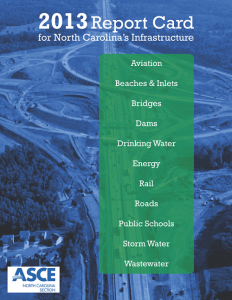 6. Five states – North Carolina, Oklahoma, Kansas, Missouri, and Washington – put out state-based Infrastructure Report Cards challenging their state’s leaders to get to work on the infrastructure issues in their area.
Thanks for your support in making these happen and we look forward to making 2014 an even bigger year for infrastructure!
6. Five states – North Carolina, Oklahoma, Kansas, Missouri, and Washington – put out state-based Infrastructure Report Cards challenging their state’s leaders to get to work on the infrastructure issues in their area.
Thanks for your support in making these happen and we look forward to making 2014 an even bigger year for infrastructure!
Tags: app, media, report card, state, state report cards, transportation, water
No Comments »



 */ ?>
*/ ?>




